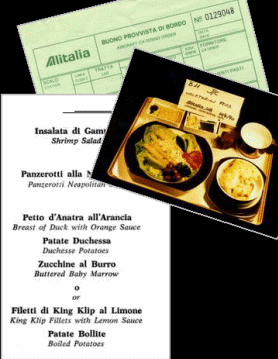Airline Catering
By Paul Dubois
|
Most people complain about airline food, but seldom consider the obstacles faced when trying to cater for everyone’s needs and offering variety - whilst flying - in an aluminum tube. With limited space, one tries to offer a choice to many different cultures and that is not even considering the logistics behind the tasks. A large airline, will produce around 16 million meals each year. Those meals in economy class, have to be mass produced with equal portions. Airline catering is a delicate juggling act between various departments facing different objectives. For example, the airline wants the best for the least cost and the caterer wants the most profit for the least output. Then you also have the cabin crew, wanting the most practical service versus the chef who usually has a huge ego and little concern for the practicality of his best dish being served on an airline. Should any part of this juggling act be overlooked, it could prove a costly mistake for the airline.
To start, one has to consider the menu, this would involve the consideration of different cultures and health issues - due to the different cultures in South Africa alone, and the large number of airlines flying into South Africa - this diversity is huge. One example was, due to sanctions placed against South Africa, South Africa had a limited number of European airlines flying to it. Thus the traveling South African developed a taste for the European culture. When the Americans started flying to South Africa again, South Africans found their menu weird to say the least. Then you have the African culture which is often overlooked by the foreign chefs employed by the airline caterers, often those of European background. Added to this, you have the challenge of creating menu changes to please your frequent flyers. You can have the finest chefs such as Jamie Oliver, but if he has no understanding of chilling, reheating , regenerating food at altitude, he will be a complete disaster. One also needs to educate the cabin crew with the correct methods of heating and serving the meals, including taking into consideration aircraft delays or delayed service due to turbulence, etc. Altitude reduces our sense of taste and affects our appetite. Woman, especially, tend to have less of an appetite when flying. Red wine will lose/change its flavour at altitude, and milk will sour quicker. Due to our reduced palate at altitude, food on aircraft needs to be a lot spicier. Wines with stronger flavour are better suited. The lower humidity and air pressure usually coupled with those alcoholic beverages drunk at the departure lounge would lead to a person becoming dehydrated in flight. Together with spicy airline food, and the salty snacks served with more alcohol, your digestion slows down and one becomes even more dehydrated. Together with a confused body clock, this leads to jet lag . Instead of passengers hoping for a fancy meal worthy of the price of the airline ticket, passengers would be better off with a low energy meal (carbohydrates) such as sautéed vegetables, pasta and fruits with loads of water. Can you imagine the reputation of an airline serving the correct meal?
This can be costly for the airline. An example of this happened with British Airway flights going via Nairobi. Economy class stainless steel cutlery was being dead headed back to London. The caterer in Nairobi was offloading the unused cutlery and returning it to Johannesburg. Before this problem was realized, Johannesburg had some 10,000 stainless steel cutlery sets whilst some other stations were reduced to having to use plastics sets. Another consideration for these flights was that due to sanctions, all South African wines etc had to be removed from flights going via Nairobi.
This is normally done by poorly paid and uneducated staff, who have little understanding of the Anglicized eating etiquette. The hot meals are normally blast
chilled down from 70 degrees Centigrade to 4 Degrees Centigrade, then
placed in the oven inserts. Remember the chef with the ego, well more
often than not, the chef will prepare what he believes is a well presented
dish but totally disregards any height restrictions. Thinking that a
piece of tin foil will suffice over casserole lids.
Often, there are many untouched meals remaining after a flight. But sadly, due to food safety laws, these meals have to be destroyed rather than going to a worthy cause. In the evening, say for 20:00 departure, the catering trucks will normally be the first to arrive at the aircraft at around 17:00. The aircraft at this stage is not connected to ground power and after standing all day under the African sun is extremely hot inside. Loading normally finishes an hour later at which time engineers & other services arrive at the aircraft and the ground power is finally switched on. The cabin crew normally arrive an hour later, leaving 30 minutes to do their checks before the passengers arrive. During this period, any missing or extra items required have to be fetched from the catering unit.
After all this effort, either the crew will incinerate the meal or the tipsy disgruntled (from a very intrusive check-in process) passenger will find fault with a meal which he would normally find acceptable in any restaurant. Copyright © Paul Dubois 2006 |

